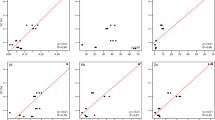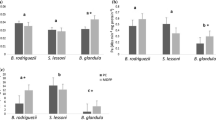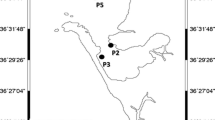Abstract
Port areas are socio-ecosystems impacted by chronic mixture pollution. Some marine species benefit from living there and may be studied to define the ecological state of such environments. In this study, the risks of chronic chemical contamination and its consequences on three marine molluscs were evaluated in North Corsica (France) port areas. Mediterranean mussel Mytilus galloprovincialis, tubular sea cucumber Holothuria tubulosa and Mediterranean limpet Patella sp. were sampled in three port areas and a reference location. A set of biomarkers was analysed to evaluate oxidative stress, detoxification, energetic metabolism, neurotoxicity, immunity and bioaccumulation (metallic trace elements and organic pollutants). The objectives were to assess pollution-induced effects in organisms, to determine the best bioindicator species for the selected locations and to validate a “pool” sampling technique (when the analysis is done on a single pool of samples and not on individual samples). The results validate the sampling techniques as “pool” for management purposes. St-Florent was demonstrated as the most contaminated location. All the other locations present a low contamination, below the recommended threshold values (for metallic trace elements and organic pollutants). Finally, the limpet appears to be the best bioindicator for the selected locations. Mussel and sea cucumber are inappropriate due to their absence in this oligotrophic region and the lack of responses observed, respectively.
Highlights
-
Limpet is a pertinent bioindicator for North Corsica ports areas monitoring.
-
Contamination in North Corsica ports is low compared to other Mediterranean ports.
-
The “pool” sampling technique could be used to obtain reliable results at lower costs.








Similar content being viewed by others
Data availability
The datasets generated during and/or analysed during the current study are available from the corresponding author on reasonable request.
References
Andral B, Stanisiere JY, Sauzade D, Damier E, Thebault H, Galgani F, Boissery P (2004) Monitoring chemical contamination levels in the Mediterranean based on the use of mussel caging. Mar Pollut Bullet 49:704–712
Aydin M, Tunca E, Alver Şahin Ü (2017) Effects of anthropological factors on the metal accumulation profiles of sea cucumbers in near industrial and residential coastlines of İzmir, Turkey. Int J Environ Analy Chem 97:368–382
Bailey DM, Genard B, Collins MA, Rees J-F, Unsworth SK, Battle EJV, Bagley PM, Jamieson AJ, Priede IG (2005) High swimming and metabolic activity in the deep-sea eel Synaphobranchus kaupii revealed by integrated in situ and in vitro measurements. Physiol Biochem Zool 78:335–346
Beg MU, Butt SA, Al-Dufaileej S, Karam Q, Al-Sharrah TK, Saeed T (2018) Biomarkers in fish as a measure of the state of marine environment of Kuwait. Environ Monitoring Assess 190:325
Beliaeff B, Burgeot T (2002) Integrated biomarker response: A useful tool for ecological risk assessment. Environ Toxicol Chem 21:1316–1322
Benali I, Boutiba Z, Merabet A, Chèvre N (2015) Integrated use of biomarkers and condition indices in mussels (Mytilus galloprovincialis) for monitoring pollution and development of biomarker index to assess the potential toxic of coastal sites. Mar Pollut Bullet 95:385–394
Bertrand L, Monferrán MV, Mouneyrac C, Amé MV (2018) Native crustacean species as a bioindicator of freshwater ecosystem pollution: a multivariate and integrative study of multi-biomarker response in active river monitoring. Chemosphere 206:265–277
Bignert A, Göthberg A, Jensen S, Litzén K, Odsjö T, Olsson M, Reutergårdh L (1993) The need for adequate biological sampling in ecotoxicological investigations: a retrospective study of twenty years pollution monitoring. Sci Total Environ 128:121–139
Bignert A, Olsson M, de Wit C, Litzén K, Rappe C, Reutergårdh L (1994) Biological variation — an important factor to consider in ecotoxicological studies based on environmental samples. Fresenius’ J Analy Chem 348:76–85
Bondaruk J, Janson E, Wysocka M, Chałupnik S (2015) Identification of hazards for water environment in the upper Silesian Coal Basin caused by the discharge of salt mine water containing particularly harmful substances and radionuclides. J Sustainable Mining 14:179–187
Breitwieser M, Dubillot E, Barbarin M, Churlaud C, Huet V, Muttin F, Thomas H (2018) Assessment of the biological quality of port areas: a case study on the three harbours of La Rochelle: The marina, the fishing harbour and the seaport. PLOS ONE 13:e0198255
Campanella L, Conti ME, Cubadda F, Sucapane C (2001) Trace metals in seagrass, algae and molluscs from an uncontaminated area in the Mediterranean. Environ Pollut 111:117–126
Cao R, Zhang T, Li X, Zhao Y, Wang Q, Yang D, Qu Y, Liu H, Dong Z, Zhao J (2019) Seawater acidification increases copper toxicity: a multi-biomarker approach with a key marine invertebrate, the Pacific Oyster Crassostrea gigas. Aquatic Toxicol 210:167–178
Caricato R, Lionetto MG, Schettino T (2010) Seasonal variation of biomarkers in Mytilus galloprovincialis sampled inside and outside Mar Piccolo of Taranto (Italy). Chem Ecol 26:143–153
Carr RS, Neff JM (1984) Quantitative semi-automated enzymatic assay for tissue glycogen. Compar Biochem Physiol Part B: Comparat Biochem 77:447–449
Childress JJ, Somero GN (1979) Depth-related enzymic activities in muscle, brain and heart of deep-living pelagic marine teleosts. Mar Biol 52:273–283
Conti ME, Mele G, Finoia MG (2017) Baseline trace metals in Patella caerulea in a central Tyrrhenian ecosystem (Pontine Islands archipelago and Lazio region coastal sites, Italy). Environ Sci Pollut Res 24:8852–8865
Cravo A, Lopes B, Serafim Â, Company R, Barreira L, Gomes T, Bebianno MJ (2009) A multibiomarker approach in Mytilus galloprovincialis to assess environmental quality. J Environ Monit 11:1673–1686
Cravo A, Pereira C, Gomes T, Cardoso C, Serafim A, Almeida C, Rocha T, Lopes B, Company R, Medeiros A, Norberto R, Pereira R, Araújo O, Bebianno MJ (2012) A multibiomarker approach in the clam Ruditapes decussatus to assess the impact of pollution in the Ria Formosa lagoon, South Coast of Portugal. Mar Environ Res 75:23–34
DCSMM (2008) Directive 2008/56/EC of 17 June 2008 establishing a framework for community action in the field of marine environmental policy (Marine Strategy Framework Directive). In Official Journal of the European Union, vol. L150: European Commission; 2008
Delahaut V, Daelemans O, Sinha AK, De Boeck G, Bervoets L (2019) A multibiomarker approach for evaluating environmental contamination: common carp (Cyprinus carpio) transplanted along a gradient of metal pollution. Sci Total Environ 669:481–492
Devin S, Burgeot T, Giambérini L, Minguez L, Pain-Devin S (2014) The integrated biomarker response revisited: optimization to avoid misuse. Environ Sci Pollut Res 21:2448–2454
Ellman GL, Courtney KD, Andres V, Featherstone RM (1961) A new and rapid colorimetric determination of acetylcholinesterase activity. Biochem Pharmacol 7:88–95
Fasulo S, Iacono F, Cappello T, Corsaro C, Maisano M, D’Agata A, Giannetto A, De Domenico E, Parrino V, Lo Paro G, Mauceri A (2012) Metabolomic investigation of Mytilus galloprovincialis (Lamarck 1819) caged in aquatic environments. Ecotoxicol Environ Saf 84:139–146
Frings CS, Fendley TW, Dunn RT, Queen CA (1972) Improved Determination of Total Serum Lipids by the Sulfo-Phospho-Vanillin Reaction. Clin Chem 18:673–675
Galgani F, Chiffoleau JF, Orsoni V, Costantini L, Boissery P, Calendini S, Andral B (2006) Chemical contamination and sediment toxicity along the coast of Corsica. Chem Ecol 22:299–312
Garric J, Morin S, Vincent-Hubert F (2010) Les biomarqueurs en écotoxicologie : définition, intérêt, limite, usage. Sciences Eaux et Territoires, Numéro 1
Gharred T, Helaoui A, Mannai R, Jebali J (2019) Effect of multiple pollution on the cholinesterase activity, morphometry and reproduction performance of Patella caerulea collected from eastern Tunisian coasts. Cahiers de Biologie Marine 60:11–20
Goldberg ED (1975) The mussel watch — A first step in global marine monitoring. Marine Pollut Bullet 6:111
Gouveia N, Oliveira CRM, Martins CP, Maranho LA, Seabra Pereira CD, de Orte MR, Harayashiki CAY, Almeida SM, Castro IB (2019) Can shell alterations in limpets be used as alternative biomarkers of coastal contamination? Chemosphere 224:9–19
Guerra-García JM, Navarro-Barranco C, Martínez-Laiz G, Moreira J, Giráldez I, Morales E, Fernández-Romero A, Florido M, Ros M (2021) Assessing environmental pollution levels in marinas. Sci Total Environ 762:144169
Habig WH, Pabst MJ, Jakoby WB (1974) Glutathione S-transferases. The first enzymatic step in mercapturic acid formation. J Biol Chem 249:7130–7139
Islam SM, Tanaka M (2004) Impacts of pollution on coastal and marine ecosystems including coastal and marine fisheries and approach for management: a review and synthesis. Mar Pollut Bullet 48:624–649
Jamieson PM, Nyirenda MJ, Walker BR, Chapman KE, Seckl JR (1999) Interactions between oestradiol and glucocorticoid regulatory effects on liver-specific glucocorticoid-inducible genes: possible evidence for a role of hepatic 11â-hydroxysteroid dehydrogenase type 1. J Endocrinol 160:103–109
Ji R, Pan L, Guo R, Zheng L, Zhang M (2019) Using multi-integrated biomarker indexes approach to assess marine quality and health status of marine organism: a case study of Ruditapes philippinarum in Laizhou Bay, China. Environ Sci Pollut Res 26:9916–9930
Lacroix C, Le Cuff N, Receveur J, Moraga D, Auffret M, Guyomarch J (2014) Development of an innovative and “green” stir bar sorptive extraction–thermal desorption–gas chromatography–tandem mass spectrometry method for quantification of polycyclic aromatic hydrocarbons in marine biota. J Chromatogr A 1349:1–10
Lafabrie C, Pergent-Martini C, Pergent G (2008) Metal contamination of Posidonia oceanica meadows along the Corsican coastline (Mediterranean). Environ Pollut 151:262–268
Lafabrie C, Pergent G, Kantin R, Pergent-Martini C, Gonzalez JL (2007) Trace metals assessment in water, sediment, mussel and seagrass species – Validation of the use of Posidonia oceanica as a metal biomonitor. Chemosphere 68:2033–2039
Lehtonen KK, d’Errico G, Korpinen S, Regoli F, Ahkola H, Kinnunen T, Lastumäki A (2019) Mussel Caging and the Weight of Evidence Approach in the Assessment of Chemical Contamination in Coastal Waters of Finland (Baltic Sea). Front Mar Sci 6:688
Lowry OH, Rosebrough NJ, Farr AL, Randall RJ (1951) Protein measurment with the Folin phenol reagent. J Biol Chem 193:265–275
Luna-Acosta A, Breitwieser M, Renault T, Thomas-Guyon H (2017a) Recent findings on phenoloxidases in bivalves. Mar Pollut Bullet 122:5–16
Luna-Acosta A, Bustamante P, Budzinski H, Huet V, Thomas-Guyon H (2015) Persistent organic pollutants in a marine bivalve on the Marennes-Oléron Bay and the Gironde Estuary (French Atlantic Coast) - Part 2: Potential biological effects. Sci Total Environ 514:511–522
Luna-Acosta A, Bustamante P, Thomas-Guyon H, Zaldibar B, Izagirre U, Marigómez I (2017b) Integrative biomarker assessment of the effects of chemically and mechanically dispersed crude oil in Pacific oysters, Crassostrea gigas. Sci Total Environ 598:713–721
Luna-Acosta A, Rosenfeld E, Amari M, Fruitier-Arnaudin I, Bustamante P, Thomas-Guyon H (2010) First evidence of laccase activity in the Pacific oyster Crassostrea gigas. Fish Shellfish Immunol 28:719–726
Maisano M, Cappello T, Natalotto A, Vitale V, Parrino V, Giannetto A, Oliva S, Mancini G, Cappello S, Mauceri A, Fasulo S (2017) Effects of petrochemical contamination on caged marine mussels using a multi-biomarker approach: Histological changes, neurotoxicity and hypoxic stress. Mar Environ Res 128:114–123
Mbandzi N, Vincent Nakin MD, Oyedeji AO (2022) Temporal and spatial variation of heavy metal concentration in four limpet species along the southeast coast of South Africa. Environ Pollut 302:119056
Mohammadizadeh M, Bastami K, Ehsanpour M, Afkhami M, Mohammadizadeh F, Esmaeilzadeh M (2016) Heavy metal accumulation in tissues of two sea cucumbers, Holothuria leucospilota and Holothuria scabra in the northern part of Qeshm Island, Persian Gulf. Mar Pollut Bullet 103:354–359
Orani AM, Barats A, Vassileva E, Thomas OP (2018) Marine sponges as a powerful tool for trace elements biomonitoring studies in coastal environment. Mar Pollut Bullet 131:633–645
Paoletti F, Aldinucci D, Mocali A, Caparrini A (1986) A sensitive spectrophotometric method for the determination of superoxide dismutase activity in tissue extracts. Analy Biochem 154:536–541
Parra-Luna M, Martín-Pozo L, Hidalgo F, Zafra-Gómez A (2020) Common sea urchin (Paracentrotus lividus) and sea cucumber of the genus Holothuria as bioindicators of pollution in the study of chemical contaminants in aquatic media. A revision. Ecol Indicators 113:106185
Pérez S, Sánchez-Marín P, Bellas J, Viñas L, Besada V, Fernández N (2019) Limpets (Patella spp. Mollusca, Gastropoda) as model organisms for biomonitoring environmental quality. Ecol Indicators 101:150–162
Petrescu I, Bojan O, Saied M, Bârzu O, Schmidt F, Kühnle HF (1979) Determination of phosphoenolpyruvate carboxykinase activity with deoxyguanosine 5′-diphosphate as nucleotide substrate. Analy Biochem 96:279–281
Rainbow PS (2002) Trace metal concentrations in aquatic invertebrates: why and so what? Environ Pollut 120:497–507
Rainbow PS, Phillips DJH (1993) Cosmopolitan biomonitors of trace metals. Mar Pollut Bullet 26:593–601
Reguera P, Couceiro L, Fernández N (2018) A review of the empirical literature on the use of limpets Patella spp. (Mollusca: Gastropoda) as bioindicators of environmental quality. Ecotoxicol Environ Saf 148:593–600
Richir J, Gobert S (2014) A reassessment of the use of Posidonia oceanica and Mytilus galloprovincialis to biomonitor the coastal pollution of trace elements: New tools and tips. Mar Pollut Bullet 89:390–406
Serafim A, Company R, Lopes B, Fonseca VF, França S, Vasconcelos RP, Bebianno MJ, Cabral HN (2012) Application of an integrated biomarker response index (IBR) to assess temporal variation of environmental quality in two Portuguese aquatic systems. Ecol Indicators 19:215–225
Shrivastava A, Gupta V (2011) Methods for the determination of limit of detection and limit of quantitation of the analytical methods. Chron Young Scientists 2:21–25
Silva CSE, Novais SC, Simões T, Caramalho M, Gravato C, Rodrigues MJ, Maranhão P, Lemos MFL (2018) Using biomarkers to address the impacts of pollution on limpets (Patella depressa) and their mechanisms to cope with stress. Ecol Indicators 95:1077–1086
Turk Culha S, Dereli H, Karaduman FR, Culha M (2016) Assessment of trace metal contamination in the sea cucumber (Holothuria tubulosa) and sediments from the Dardanelles Strait (Turkey). Environ Sci Pollut Res 23:11584–11597
Turle R, Collins B (1992) Validation of the use of pooled samples for monitoring of contaminants in wildlife. Chemosphere 25:463–469
Uluturhan E, Darılmaz E, Kontas A, Bilgin M, Alyuruk H, Altay O, Sevgi S (2019) Seasonal variations of multi-biomarker responses to metals and pesticides pollution in M. galloprovincialis and T. decussatus from Homa Lagoon, Eastern Aegean Sea. Mar Pollut Bullet 141:176–186
Wang WX (2016) Chapter 4 - Bioaccumulation and Biomonitoring. In: Blasco J, Chapman PM, Campana O, Hampel M (Eds.) Marine Ecotoxicology. Academic Press, London, 99–119
Acknowledgements
The authors are grateful to Mr B. Pantalacci, manager of the shellfish farm SARL Etang de Diane, and his employees who provided mussels.
Funding
This work was supported by the “QUAlity of the marine environment in the Mediterranean POrt areas” (QUAMPO) project, funded by the “Fonds Européen pour les Affaires Maritimes et la Pêche” (FEAMP) - European Maritime and Fisheries Fund (EMFF) [grant number PFEA800219DM0940001, 2019].
Author information
Authors and Affiliations
Contributions
MP: Conceptualisation, methodology, validation, data collection, formal analyses, investigation, supervision, writing. MD: Methodology, data collection, formal analyses. MM: Conceptualisation, methodology, validation, data collection, supervision, project administration, funding acquisition. LF: Writing. ML: Methodology, data collection. QF: Formal analyses. SLF: Methodology, formal analyses. VH: Formal analyses. CC: Formal analyses. PL: Conceptualisation, funding acquisition. HT: Supervision, project administration, funding acquisition.
Corresponding author
Ethics declarations
Conflict of interest
The authors declare no competing interests.
Consent to participate
Yes.
Consent to publish
Yes.
Additional information
Publisher’s note Springer Nature remains neutral with regard to jurisdictional claims in published maps and institutional affiliations.
Supplementary information
Rights and permissions
Springer Nature or its licensor (e.g. a society or other partner) holds exclusive rights to this article under a publishing agreement with the author(s) or other rightsholder(s); author self-archiving of the accepted manuscript version of this article is solely governed by the terms of such publishing agreement and applicable law.
About this article
Cite this article
Pillet, M., Dabrowski, M., Marengo, M. et al. Preliminary inter-port study of the quality of environments using physiological responses of invertebrates exposed to chronic trace element and organic contamination in Corsica (Mediterranean Sea). Ecotoxicology 32, 243–260 (2023). https://doi.org/10.1007/s10646-023-02635-w
Accepted:
Published:
Issue Date:
DOI: https://doi.org/10.1007/s10646-023-02635-w




